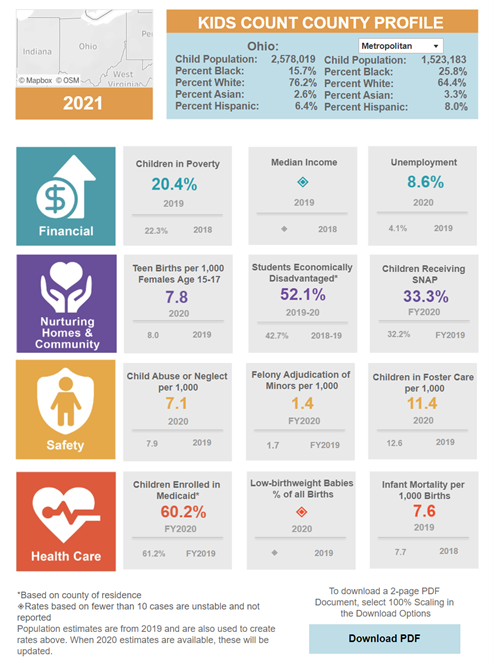KIDS COUNT County Profiles Update: New Regional Analysis for Whole Child-Wellbeing
Measures
 By: Morghan Hyatt, Data Policy Associate
By: Morghan Hyatt, Data Policy Associate
Children’s Defense Fund-Ohio’s new regionally disaggregated measures for whole child well-being take a deeper dive into the progress that children have made throughout the development of the COVID-19 public health emergency.
This past August, CDF-Ohio announced the release of our 2021 KIDS COUNT County Profiles, data profiles that provide a roadmap to data- and equity-driven recovery focused on children and families.- Using the updated to make their case clear, advocates with CDF-Ohio urged state and local leaders to invest American Rescue Plan Dollars based on an equity-focused lens, with engagement of community voice, and in ways that highlight data and prioritize child wellbeing. The comprehensive snapshots of state, county and district level-data gave unique insight to allocating ARPA dollars to families that need them most. Now, a new comparative regional analysis updated this week within the 2021 KIDS COUNT County Profiles enables a closer look at patterns and trends within Appalachian, Metropolitan, Rural and Suburban communities.
The U.S. Census Bureau and the 2019 Ohio Medicaid Assessment Survey categorizes counties or otherwise equivalent entities into regions based on population, housing and territorial comparisons in Rural Appalachian, Urban, Rural Non-Appalachian, Metropolitan and Suburban areas. An adapted use of the Census Bureau’s categorization was tailored to identify counties in Ohio by region: Appalachian; Metropolitan; Rural; and Suburban. In the updated KIDS COUNT County Profiles, these regions, or broader-scaled analyses, highlight underlying social and economic conditions both before and throughout the pandemic.
Appalachia– Before the start of the public health emergency in 2019, the number of children living in poverty within Appalachia was 20.8%, – about 42,000 more children struggling than in the Rural region. In 2020, unemployment in the Appalachian area increased from 5.2% to 8.2% consequently making it harder for families to stay afloat amidst the pandemic.
Metropolitan– Over 50% of students were economically disadvantaged in the 2019-2020 school year; yet, 1 in 3 children received SNAP making it possible for children to receive adequate food and groceries.
Rural– Despite having one of the smallest child populations amongst the four regions, the Rural region had the highest decrease in infant mortality, 8.1%, moving from 5.8 to 5.4 per 1,000 children and maintaining the lowest rate overall right before the start of the pandemic in 2019.
Suburban– From FY2019 to FY2020, an increase of almost 5% occurred for Ohio adjudicated youth compared to Appalachian, Metropolitan and Rural regions that saw decreases in that same measure.
These regional data give a glimpse of how families and children have had to push through many of the erased gains that were made prior to the start of the pandemic. The importance of visualizing data on a regional level gives geographical context to the needs of different communities in Ohio, and further gives credence to the reality that a one-size fits all approach is ineffective in addressing the concerns that diverse areas face.
These KIDS COUNT County Profiles can be used as a multi-faceted tool to disaggregate information in various ways that tell the story of how children and families have faced challenges throughout the pandemic. A regional analysis adds a meaningful layer and finer examination of the whole child-wellbeing framework building upon the originally included state, county, and district level analyses.
As CDF-Ohio continues to monitor data from Ohio’s Appalachian, Metropolitan, Rural and Suburban regions, we continue to advocate for resources that these communities need on an individualistic basis.
Using data-informed and data-driven strategies when it comes to whole child-wellbeing initiatives not only allow quantitative and qualitative information to guide decision-making for policy makers, but it also continues to check the progress that families and children are making within communities in Ohio. As we strive to make continuous updates in how we visualize and analyze data, we remain resolutely committed to reimagining the ways data can be utilized to serve Ohio’s children best.

